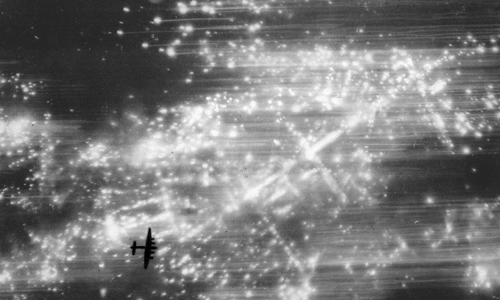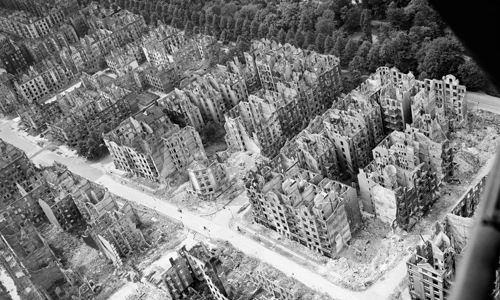The Allies deployed 3,000 aircraft and dropped 9,000 tons of bombs on Hamburg in 1943 with the aim of destroying Germany's war potential.
City air strikes aimed at destroying the enemy's industry took place regularly during World War II. Of these, the Allied Gomorrah campaign aimed at the city of Hamburg, Germany, was considered to be the largest air assault in history.

British aircraft bombed Hamburg during Operation Gomorrah Photo: BBC
In the early stages of World War II, Britain believed that wide-range bombardment would destroy strategic objectives and render Germany incapable of fighting. The British aircraft then targeted only military bases. The fact that German aircraft accidentally bombed civilian targets in London in 1940 created an excuse for Britain to retaliate when targeting enemy cities.
Hamburg, Germany's second largest city, is a major industrial center, with a port connecting the North Sea and a transport center. Many of Germany's refineries, shipyards and industrial facilities were located in the city, making it an Allied top target.
On January 21, 1943, the Allies adopted a war order called Attack on the Plains of Bombers to destroy the German economic, industrial and military systems, as well as to destroy the morale of the people. this country.
The British Air Force bomber command was responsible for the night raids, while the US 8th Air Force Command carried out daytime air strikes. Air Force Marshal Travers Harris believes that causing damage to German workers and their families is just as effective as destroying industrial plants.
"The Nazis fought the illusion that they could bomb other countries without retaliation. They sowed wind in many cities and now will have to reap storms in their homeland," Marshal Harris said. On May 27, 1943, Harris signed orders 173, launching a bombing campaign under the code name Gomorrah.
During the German air campaign of 1941-1942, British aircraft were often shot down by German anti-aircraft and anti-aircraft guns, causing great loss of lives and armaments. Learning from this operation, the British Air Force used a decoy bait to trick the German radar into Gomorrah. The pilots dropped large clusters of metal fibers, making it impossible for the enemy radar to catch the bomber.
On the night of July 24 and morning, 791 British bombers began their first 50-minute offensive with 2,400 tons of bombs dropped on the German city. High-explosive bombs are dropped first to destroy the roof, before the bomb is used.
About 40,000 firefighters in Hamburg at the time, but they could not move around the streets to put out the fire. The flames from the air strike smoldered for three days. He only lost 12 aircraft using bait deceive radar.

A corner of Hamburg after an Allied air raid Photo: IWM
"We were surprised by the method of ambushing Hamburg. The new equipment made the anti-aircraft artillery batteries helpless. This is a very successful air attack and is used many times in Hamburg," said Albert Speer, former ministry. Head of Equipment and War Industry under Hitler, reminisces.
The second raid took place at 16h40 on July 25. The US Air Force deployed 90 B-17 bombers to the engine factory, as well as the Blohm and Voss shipyards. During this attack, 78 US aircraft were damaged by anti-aircraft fire. Germany must mobilize more firefighters from other cities to put out the fire in Hamburg.
The next night's raid was destroyed by smoke from the fires, forcing 700 British bombers to attack the city of Essen.
During the attack Tuesday morning 26/7, the British Air Force just dropped two bombs on the German city and had to return because of bad weather. On the night of 27 and 28 morning, 787 British planes took part in the bombardment of Hamburg. Dry weather and a bombardment focused on an area with many other factors causing Hamburg to sink in a firestorm.
"Large flames enveloped the street. I tried to run against the wind but only reached a house on the corner of Sorbenstrasse. We could not cross Eiffestrasse because the asphalt had melted. Many people were lying on the road," some are dead, others flabby with their feet trapped in asphalt and constantly screaming, "Kate Hoffmeister, a resident of Hamburg, told of the 1943 fire storm.
The Allied air raid created a 3.5 km diameter fire storm with a central temperature of 800 degrees Celsius. All wood, paper and cloth items were immediately burned to ashes when the fire storm swept. cross, while aluminum and lead melting, steel is deformed. People in the bomb shelter also suffocated because of lack of oxygen.
Operation Gomorrah was scheduled to take place until 3/8 but the last raid in was canceled due to bad weather. Allied air strikes in this campaign left more than 42,000 dead, 37,000 injured and one million homeless. A total of about 3,000 aircraft participated in the campaign with nearly 9,000 tons of bombs dropped on Hamburg.
"If the Allies continue bombing 4-5 other cities at a similar level, Germany will collapse much faster," Speer said.



 BryanHepp
BryanHepp







